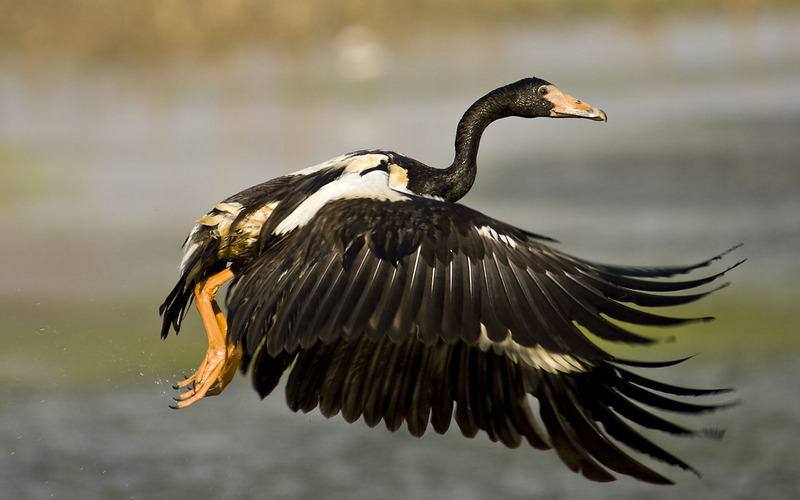|
| Query: Anseranas semipalmata | Result: 2nd of 17 | |
Magpie-goose (Anseranas semipalmata) - Wiki
| Subject: | Magpie-goose (Anseranas semipalmata) - Wiki
| |

| Resolution: 1280x800
File Size: 147056 Bytes
Date: 2007:10:05 08:21:10
Camera: NIKON D2X (NIKON CORPORATION)
F number: f/5.6
Exposure: 1/640 sec
Focal Length: 4000/10
Upload Date: 2008:01:08 15:41:30
|
Magpie-goose
From Wikipedia, the free encyclopedia
Order: Anseriformes
Family: Anseranatidae
[Photo] Magpie-goose (Anseranas semipalmata) taking off. Date: 5 October 2007. Author: Paul Thomsen (http://en.wikipedia.org/wiki/User:Djambalawa). Copyright (C) 2007 Paul Thomsen
Permission is granted to copy, distribute and/or modify this document under the terms of the GNU Free Documentation License, Version 1.2 or any later version published by the Free Software Foundation; with no Invariant Sections, no Front-Cover Texts, and no Back-Cover Texts. A copy of the license is included in the section entitled "GNU Free Documentation License". |
The Magpie-goose, Anseranas semipalmata is an unusual member of the bird order Anseriformes, the latter containing about 150 living species in three families.
The Magpie-goose is a resident breeder in northern Australia, (where it is not threatened and has a controlled hunting season when numbers are large), and southern New Guinea. It is found in a variety of open wet areas such as floodplains and swamps. It is fairly sedentary apart from some movement during the dry season.
Its nest is on the ground, and a typical clutch is 5-14 eggs. Some males mate with two females.
Magpie-geese are unmistakable birds with their black and white plumage and yellowish legs. The feet are only partially webbed, although the Magpie-goose will feed on vegetable matter in the water as well as on land. Males are larger than females. Unlike true geese, the moult is gradual, and there is no flightless period.
They are colonial breeders and are gregarious outside of the breeding season when they can form large and noisy flocks of up to a few thousand individuals. The voice is a loud honking.
This species is distinctive enough to be the sole member of the Anseranatidae; the other two living families are the Anhimidae, the screamers, and the Anatidae, the ducks, geese, and swans. The Magpie-goose is the only member of its genus Anseranas
This family is quite old, having apparently diverged before the Cretaceous???Tertiary extinction event. The fossil record is limited, nonetheless, with an undescribed species from the Late Oligocene of Billy-Cr??chy (France) being known (Hugueney et al, 2003). The enigmatic genus Anatalavis (Hornerstown Late Cretaceous/Early Paleocene of New Jersey, USA - London Clay Early Eocene of Walton-on-the-Naze, England) is sometimes considered to be the earliest known anseranatid.
Conservation Status
State of Victoria, Australia
The Magpie Goose is listed as threatened on the Victorian Flora and Fauna Guarantee Act 1988. Under this Act, an Action Statement for the recovery and future management of this species has not been prepared.
On the 2007 advisory list of threatened vertebrate fauna in Victoria, this species is listed as near threatened.
http://en.wikipedia.org/wiki/Magpie-goose
| The text in this page is based on the copyrighted Wikipedia article shown in above URL. It is used under the GNU Free Documentation License. You may redistribute it, verbatim or modified, providing that you comply with the terms of the GFDL. |
|
Comments |
|---|
| | Guest |
|
Scientific Name: Anseranas semipalmata (Latham, 1798)
Common Names: Magpie Goose
French: Canaroie semipalmée; German: Spaltfußgans; Spanish: Ganso urraca;
Taxonomy: Anas semipalmata Latham, 1798, Hawkesbury River, New South Wales, Australia. |
 |

|

|
Anseranas semipalmata
2/17 |

|

|
^o^
Animal Pictures Archive for smart phones
^o^
|
|
|

